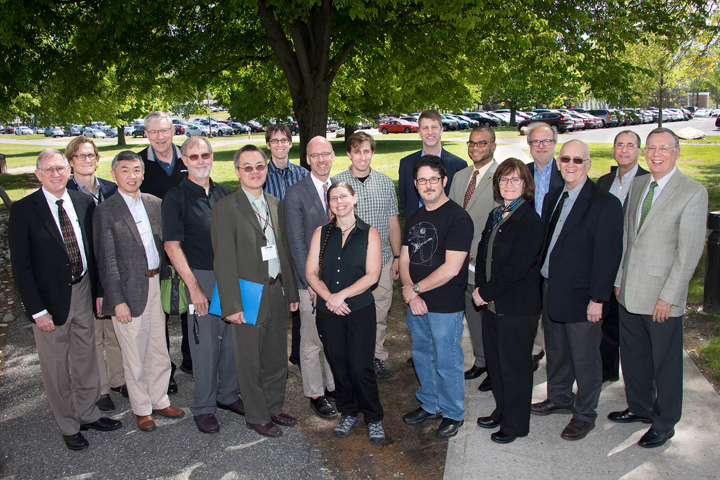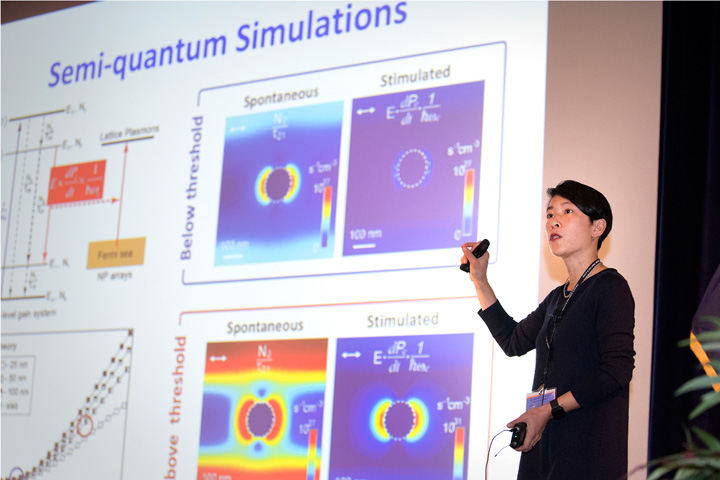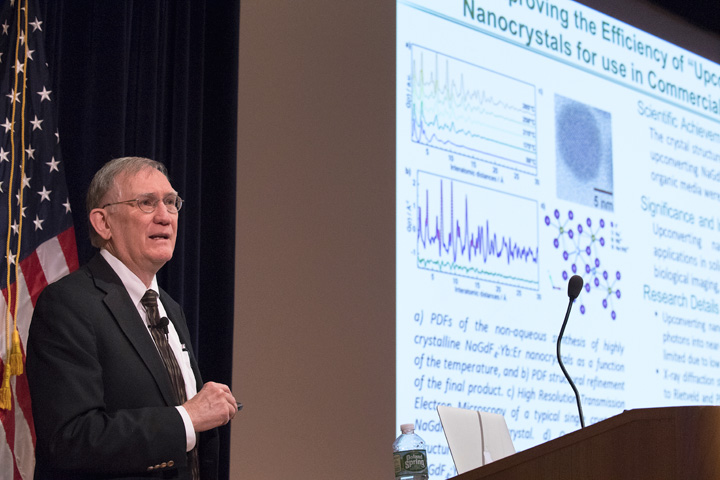Welcoming a Bright Future: 2017 NSLS-II and CFN Joint Users' Meeting
July 25, 2017
 enlarge
enlarge
During the 2017 Joint Users' Meeting CFN and NSLS-II management met with Bruce Garrett and the Users Executive Committee of both facilities. From left to right: Bruce Garrett, Jeffrey Fitts, Qun Shen, Stephen Sutton, Glenn Waychunas, Stanislaus Wong, Kevin Yager, John Hill, Jen Bohon, Eric Muller, Jan Folkson, Chuck Black, Noel Blackburn, Jean, Jordan-Sweet, Don DiMarzio, Donald Weidner, Paul Zschack, Emilio Mendez.
The event theme of this year’s Joint User’s Meeting of the National Synchrotron Light Source II (NSLS-II) and the Center for Functional Nanomaterials (CFN), two U.S. Department of Energy (DOE) Office of Science User Facilities located at Brookhaven National Laboratory, resonated well with the future research at both facilities: “Making and Measuring in 4-Dimensions.”
The scientific talks during the May 15-17 meeting’s plenary session and nine targeted workshops largely touched upon this theme. The meeting’s keynote speaker, Teri Odom, Charles E. and Emma H. Morrison Professor and Associate Chair of the Department of Chemistry, Northwestern University, whose group focuses on designing structured nanoscale materials with exceptional properties, gave a talk on nano-lasing, one of the applications of their work.
Lab and facility leaders presented overviews of activities at NSLS-II and CFN during the past year and provided insights into what users can expect in the coming year and beyond. Despite an uncertain budget environment, they conveyed the excitement of continuing (and remarkably rapid) progress at NSLS-II and the steady growth and success of the CFN.
Remarks by the Lab Director and DOE
Brookhaven Lab Director, Doon Gibbs, opened the plenary session on May 16. This annual meeting, he said, continues to be a valuable event for the NSLS-II and CFN user scientists. With electronic communication being the norm nowadays, the Users’ Meeting is a way for researchers to connect face-to-face and provide personal feedback to facility staff.
Gibbs took the opportunity to stress two key values that help to define Brookhaven, namely safety and diversity/inclusion. The latter, in particular, is a source of concern, he said, as the number of students entering STEM fields (science, technology, engineering, and mathematics) is dropping, and there are fewer international scientists who choose to stay in the U.S. after coming here to study and perform research. These trends are troubling, he said, and our country as a whole should be doing more to attract STEM students and scientists.
The science is coming out and it’s getting exciting
Doon Gibbs, Laboratory Director
The NSLS-II and CFN facilities, however, are beacons to students and researchers from home and abroad. The excitement continues to build for the potential of NSLS-II to yield brand-new discovery science, as more beamlines open for business and new papers are published on a monthly basis.
“The science is coming out and it’s getting exciting,” said Gibbs.
The DOE was represented at the meeting by Bruce Garrett, Director of the Chemical Sciences, Geosciences, & Biosciences Division, U.S. Department of Energy, Office of Basic Energy Sciences. He discussed the NSLS-II and CFN as well as other DOE user facilities in terms of the defining mission of the DOE Office of Science: to deliver scientific discoveries and major scientific tools to transform our understanding of nature and to advance the energy, economic, and national security of the United States. To that end, DOE has defined several “grand challenge” focus areas, which include studying the quantum behavior of materials and designing materials at the nanoscale that rival what is seen in nature.
NSLS-II Beamlines: Now, Coming Soon, and Beyond
John Hill, Deputy Associate Laboratory Director for Energy Sciences & Photon Sciences and Director of NSLS-II, presented the past and future progress of NSLS-II’s accelerator and beamlines.
The accelerator’s performance has been outstanding, he said. Recently, the current was increased to 300 milliamps (mA) and the ring is running in top-off mode. This achievement is the result of an aggressive ramp-up schedule and a significant effort by NSLS-II’s entire accelerator staff, beginning back in October of 2014 when they began with just 25 mA. During the upcoming cycle, the goal is to push the current to 350 mA. At the end of 2018, the team plans to achieve 400 mA with an ultimate goal of 500 mA in the future.
Reliability, too, has been excellent considering that NSLS-II is still a very young machine – it was 96.4 percent this past year.
These achievements are more notable considering that beamlines were being installed and commissioned at the same time, activities that could have been very disruptive to the storage ring’s performance.
“This gives you a sense of how much effort it was to deliver 300 mA at 96 percent reliability,” said Hill. “We are proud of the Accelerator Division and what they’ve been able to accomplish.”
At the time of the meeting, there were 19 beamlines either in commissioning or operating. Considering that it takes about a year to get one beamline up and running, having 19 beamlines built, said Hill, “is something like a world record.” By the end of the next fiscal year, 28 will be operational, putting the facility at about half of its fully built-out capacity.
The light source had hosted 567 users as of the meeting, half of whom had not been users at the original NSLS. And in June, NSLS-II welcomed its 1000th unique user over the lifetime of the facility. With users come papers, and so far, 60 have been published that involved data taken at NSLS-II, including 12 in premier publications.
Hill discussed some recent science highlights, such as at the Hard X-Ray Nanoprobe (HXN) 3-ID beamline, where researchers tagged membrane proteins with erbium ions to achieve the highest resolution 3D X-ray fluorescence image ever taken of a biological cell. This brand-new approach may become useful in other life science research.
At the Coherent Hard X-Ray Scattering (CHX) 11-ID beamline, a user group was studying the dynamics of polymers in gels, specifically for applications in artificial skin. They illuminated their samples with coherent light and analyzed the diffraction patterns to learn about the materials’ properties.
Looking ahead, said Hill, the NSLS-II team will focus on building out the facility and establishing new partnerships and sources of funding. For example, New York State is supporting a new beamline that will provide hard x-rays for studies in advanced energy applications, an area where the State would like to see progress.
It’s an exciting time at NSLS-II, I say this every year, and it remains true.
John Hill, Deputy Associate Laboratory Director for Energy Sciences & Photon Sciences and Director of NSLS-II
Hill discussed another exciting development, the push to build a cryo-electron microscopy (Cryo-EM) facility alongside NSLS-II, with the idea that the two facilities would complement each other. Cryo-EM technology is growing rapidly in the structural biology community, a key group of users at NSLS-II. A cryo-electron microscope can image large-scale protein complexes while protein crystallography, using x-rays, can yield detailed structures of pieces of the complex. New York State has pledged 15 million toward a Cryo-EM facility at Brookhaven, which will go toward an initial microscope and a building to house it.
“It’s an exciting time at NSLS-II,” said Hill. “I say this every year, and it remains true.”
CFN Approaches 10 Years of Excellence
In his remarks, the Director of the Center for Functional Nanomaterials (CFN), Chuck Black, made clear that the facility continues to thrive as it nears its 10-year anniversary next May. How does the CFN execute its mission? “We continue to offer CFN users a supported research experience working with top-caliber scientists and using state-of-the-art nanoscience instruments.”
Last year the CFN supported 505 user scientists — the most ever for a single year. Research carried out by CFN user and staff scientists resulted in 292 publications, which is another record high for the facility. More than a third of these appeared in high-impact nanoscience journals Black also noted with satisfaction that all three Brookhaven projects that won R&D 100 awards in 2016 had made use of CFN facilities.
CFN and NSLS-II have long enjoyed a strong working partnership innovating and supporting new X-ray instruments for nanoscience, beginning more than eight years ago in partnership with NSLS. In the past year, all four partner instruments at NSLS-II have started operations — the result of many years of investments and hard work by CFN and NSLS-II staff. These include X-ray surface science instruments for ambient pressure X-ray photoelectron spectroscopy (AP-XPS) at beamline CSX-II and for aberration-corrected low-energy electron microscope/photoelectron emission microscopy (AC-LEEM/XPEEM) at beamline ESM. Two different X-ray scattering instruments, the Complex Materials Scattering (CMS) 11-BM beamline, and the Soft Matter Interfaces (SMI) 12-ID beamline, have begun operations earlier this year.
In addition to these partner X-ray nanoscience instruments, in the last year the CFN has continued to invest in bringing new capabilities online for the user community, These include a adding a nanoscale 3D printer with a resolution of a few hundred nanometers to the nanofabrication facility, upgrading the operando transmission electron microscope with electron energy loss spectroscopy, upgrading the ultrafast laser spectroscopy instrument for improved energy- and time resolution, and bringing online an instrument for electrical characterization at variable temperatures.
Black closed his presentation by saying that the CFN continues to strongly align itself with Department of Energy mission, which is “to ensure America's security and prosperity by addressing its energy, environmental and nuclear challenges through transformative science and technology solutions.” He affirmed the CFN commitment to excellence, and stressed that the facility cannot achieve its goals without an engaged community of talented users.
Planning for the Future – Strategically
How NSLS-II develops and stays current in the years ahead – that is, what kinds of beamlines and techniques it wants to focus on – is something that requires a lot of thought and discussion. Recently, NSLS-II leaders completed a strategic plan to guide the NSLS-II project into the future.
 enlarge
enlarge
Teri Odom, the meeting's keynote speaker and Charles E. and Emma H. Morrison Professor and Associate Chair of the Department of Chemistry at Northwestern University, speaks about nano-lasing. Nano-lasing is an application of her work in designing structured nanoscale materials with exceptional properties.
Qun Shen, Deputy Director for Science at NSLS-ll, summarized this plan during his talk. He said that the future of NSLS-II must be considered within a world-wide view that takes several factors into account.
“All our previous planning has focused on new beamlines, what to construct, and science priorities,” he said. “The new plan, which is available online, takes into account the current state of operations, a tough financial climate, and the evolving synchrotron light source landscape in a global context.”
Currently, NSLS-II is a world-leader in synchrotron technology, with much of its potential still untapped. It has the power to be transformative in advancing synchrotron science to address society’s grand challenge problems. NSLS-II will also help cultivate and develop new scientific communities whose research would benefit from high-brightness light sources.
The plan identifies three broad science directions: emergent behavior and complexity, in situ and operando science, and multi-scale structure/function research. It also recommends pursuing four areas that will enable the best light source technology: accelerator development, x-ray optics and detectors, multi-modal and operando sample environments and experiments and data-driven science and data management.
“To beef up the experimental programs, the plan is to enhance what is already in place, deliver new beamlines, and become more efficient so that more users can get beam time,” Shen said. “Developing new beamlines with grand-challenge science problems in mind is going to be key.”
R&D efforts will include nanofocusing optics development and advanced detectors to rapidly collect data. In the coming years, NSLS-II, along with the Lab as a whole, will be working to greatly improve their data analysis capabilities via its new Computational Science Initiative.
Spotlight Notes from the Nine Workshops
In addition to the plenary session, nine workshops were held that targeted various aspects of the meeting’s theme.
The first workshop tackled the great challenges that come with “Multi-dimensional and Multi-modal X-ray Imaging and Analysis,” a powerful research approach that combines various techniques and wavelengths to collect extensive information from a single sample. The presentations and discussions in the workshop centered on feasible solutions for multi-dimensional and multi-modal data collection, pre-processing, correlation, and analysis. The researchers agreed that a “hybrid” approach combining researchers, software developers, and engineers from collaborations across academia, government laboratories, and industry will yield the most promising solutions.
Download summary for Workshop 1
 enlarge
enlarge
Bruce Garrett, Director of the Chemical Sciences, Geosciences, & Biosciences Division, U.S. Department of Energy, Office of Basic Energy Sciences discussed the role of NSLS-II and CFN in terms of the defining mission of the DOE Office of Science.
The second workshop, entitled “Spectro-microscopy at the Nanoscale: Exploring Chemical, Electronic and Magnetic Properties of Novel Materials,” brought together world-leading experts in electron spectro-microscopy to explore new challenges in technique development and multi-dimensional, multi-set data acquisition and analysis. The scientific talks and discussions spanned topics from new experimental capabilities for spectro-microscopic characterization of emerging materials, new spin filters, and detectors, to the theory of electron optics, offering the scientists an engaging exchange across various fields of study.
Download summary for Workshop 2
A dedicated workshop about “Synchrotron Techniques in Support of DOE’s Subsurface R&D Effort” featured researchers discussing how existing facilities could be leveraged to support this effort. The workshop yielded several suggestions to improve assistance and collaboration, such as common standards for all participants, an overarching research agenda, and the need for a facility that would allow off-line experiments.
Download summary for Workshop 3
Leading researchers in the field of diffuse scattering gathered for the “Measurement and Interpretation of Diffuse Scattering in X-Ray Diffraction for Macromolecular Crystallography” workshop. A major focus of the workshop was to provide a roadmap to the acquisition of reliable data by surveying measurement methods and discussing the increase in measurement accuracy enabled by improved detectors, experimental methods, and data integration. The researchers concluded that much has been accomplished, with notable advances in data collection, processing, and molecular dynamics simulations, but further progress is needed in both accurate data collection and modeling to increase the overall correlations between models and experiment.
Download summary for Workshop 4
In the “Bringing Science into the Classroom” workshop, NSLS-II, CFN scientists, educators and school administrators discussed how the two facilities’ tools can be used to promote authentic, student-driven research in the classroom and its future impact on workforce development. The discussion focused on best practices for reaching the community and promoting the Lab’s values to the community it serves.
Download summary for Workshop 5
The “Polarized Resonant Soft X-ray Scattering at NSLS-II” or PRSoXS workshop showcased the successes and future potential of PRSoXS, which impacts fields from advanced materials to biology. The workshop was organized in short topical talks with an impressive range to address the future of PRSoXS studies and opportunities. Additionally, the National Institute of Standards and Technology (NIST) introduced its plan for a new PRSoXS capability—with unprecedented signal-to-noise detection and both high throughput and in-situ environments—as part of one of NIST’s suite of beamlines at NSLS-II that will come online in the next year.
Download summary for Workshop 6
The speakers at the “Prospects in Imaging Materials and Their Dynamics by Coherent X-ray Scattering” workshop covered a variety of topics, ranging from overviews on the current use of x-ray beam coherence for the investigation of structure and dynamics of nanoscopic objects to studies on the macroscopic scale in advanced materials, batteries, and biominerals. The attention to technical detail on how to exploit the spectacular potential of modern sources was a center point in all discussion that followed, and the attendees agreed that a similar workshop would foster a bright future of the field.
Download summary for Workshop 7
As one of the workshop sessions NSLS-II held a “DAMA Python Data Acquisition Software Tutorial” to familiarize attendees with the possibilities this new tool offers. The workshop covered all the key skills that both beginner and expert Python users would need to use this software tool during future beam time.
Download summary for Workshop 8
The “Nano-mechanics: From Material Fabrication to In-Operando Characterization” workshop brought together experts in nanomechanics, material fabrication, and structural probing to present and discuss the designs and properties of nanoscale materials and the measurement challenges that come with the wide size scale of these materials.
Download summary for Workshop 9
Feedback from workshop participants indicated they enjoyed the stimulating and engaging discussion across various fields of research and used this opportunity to exchange ideas, knowledge, and experience. NSLS-II and CFN look forward to hosting their next joint Users’ Meeting in 2018.
Brookhaven National Laboratory is supported by the Office of Science of the U.S. Department of Energy. The Office of Science is the single largest supporter of basic research in the physical sciences in the United States, and is working to address some of the most pressing challenges of our time. For more information, please visit science.energy.gov.
Follow @BrookhavenLab on Twitter or find us on Facebook.
2017-12263 | INT/EXT | Newsroom









